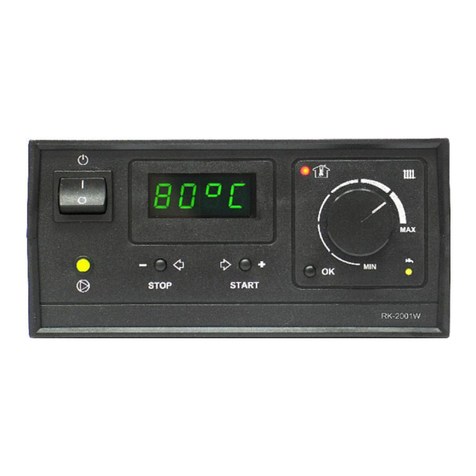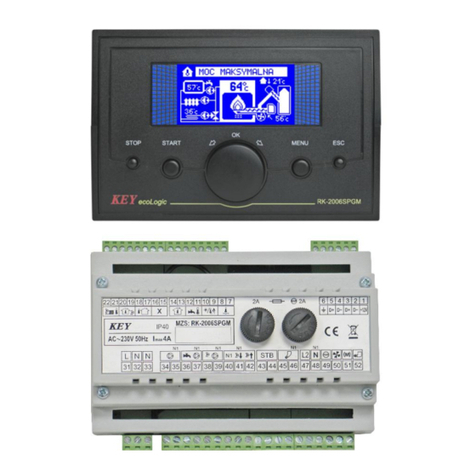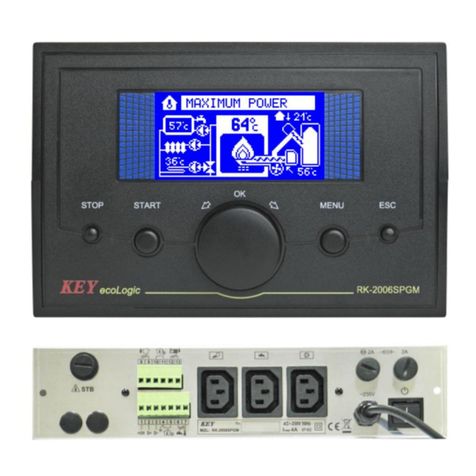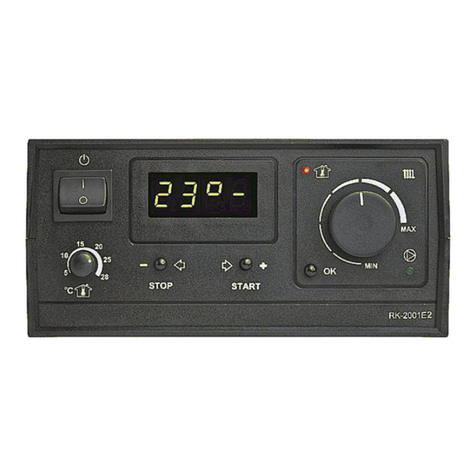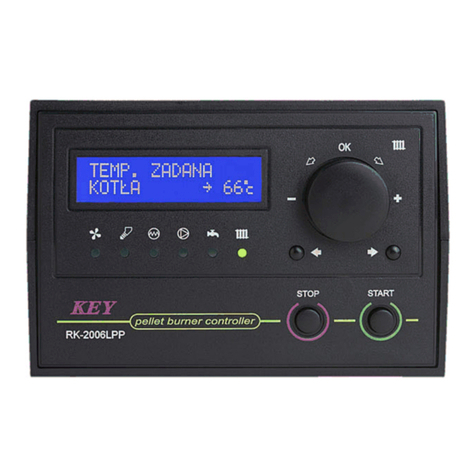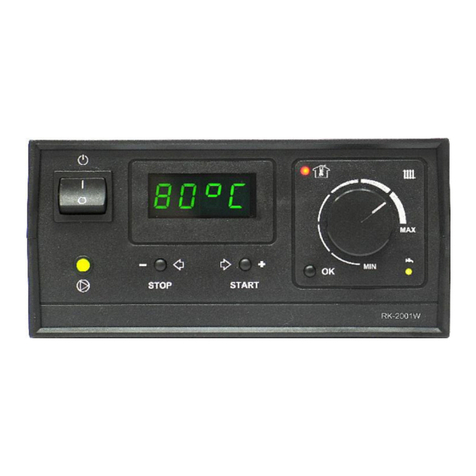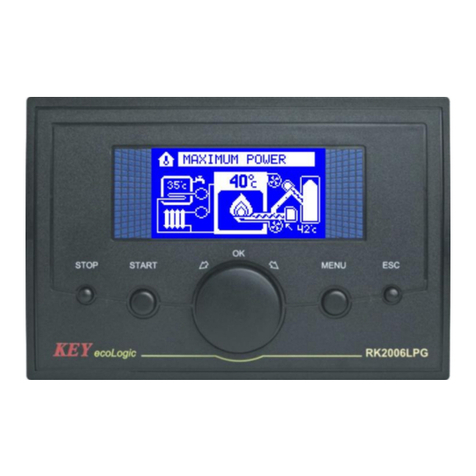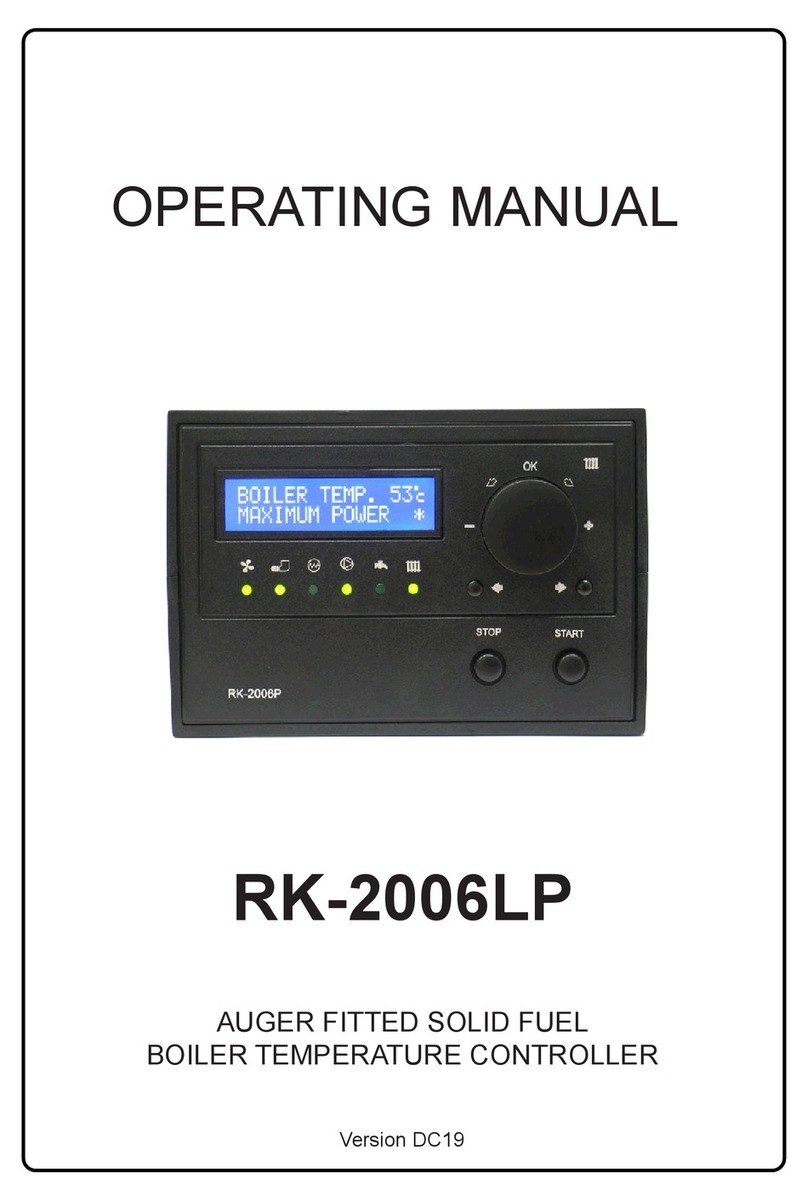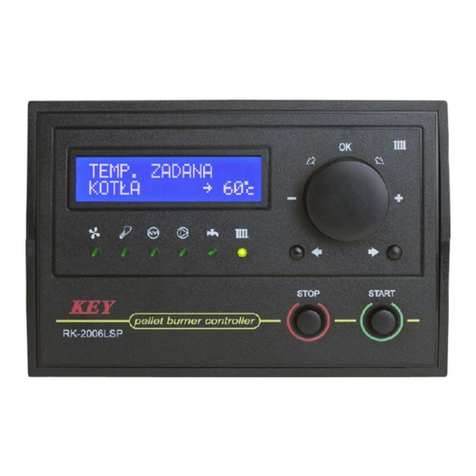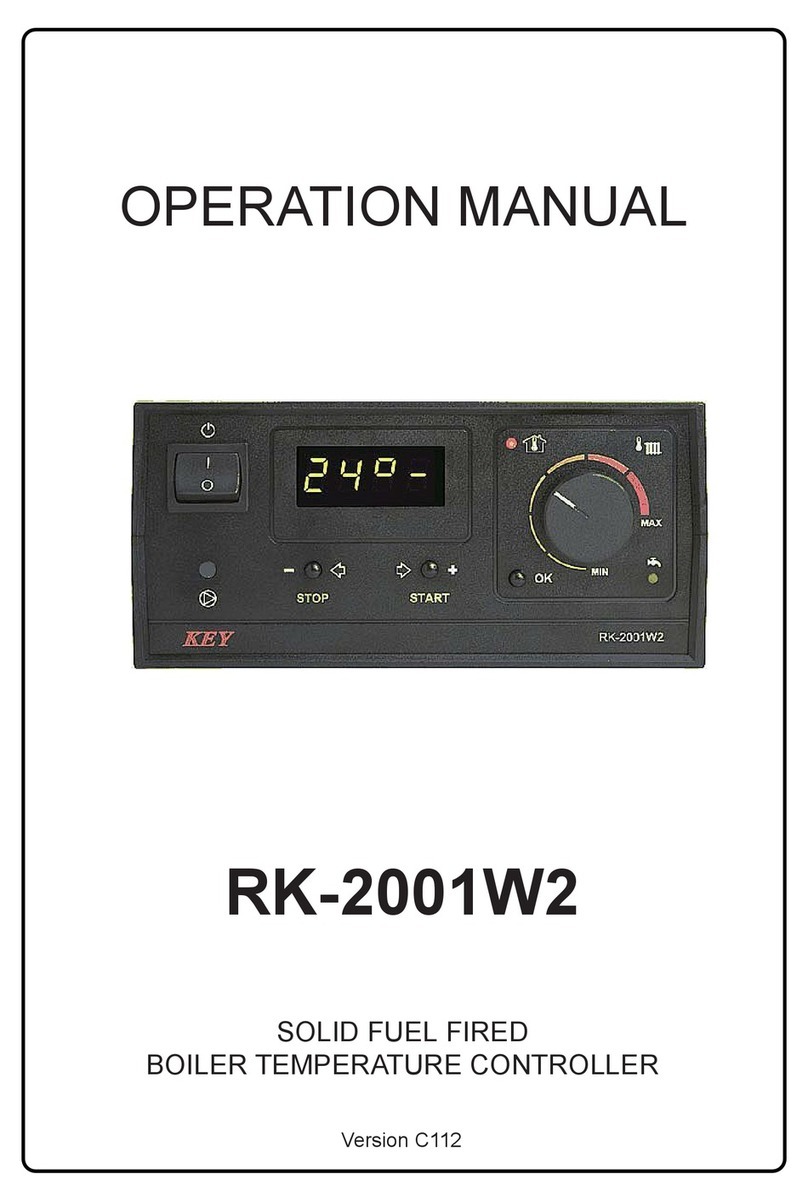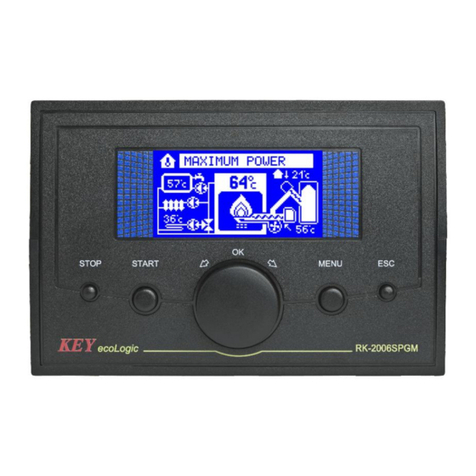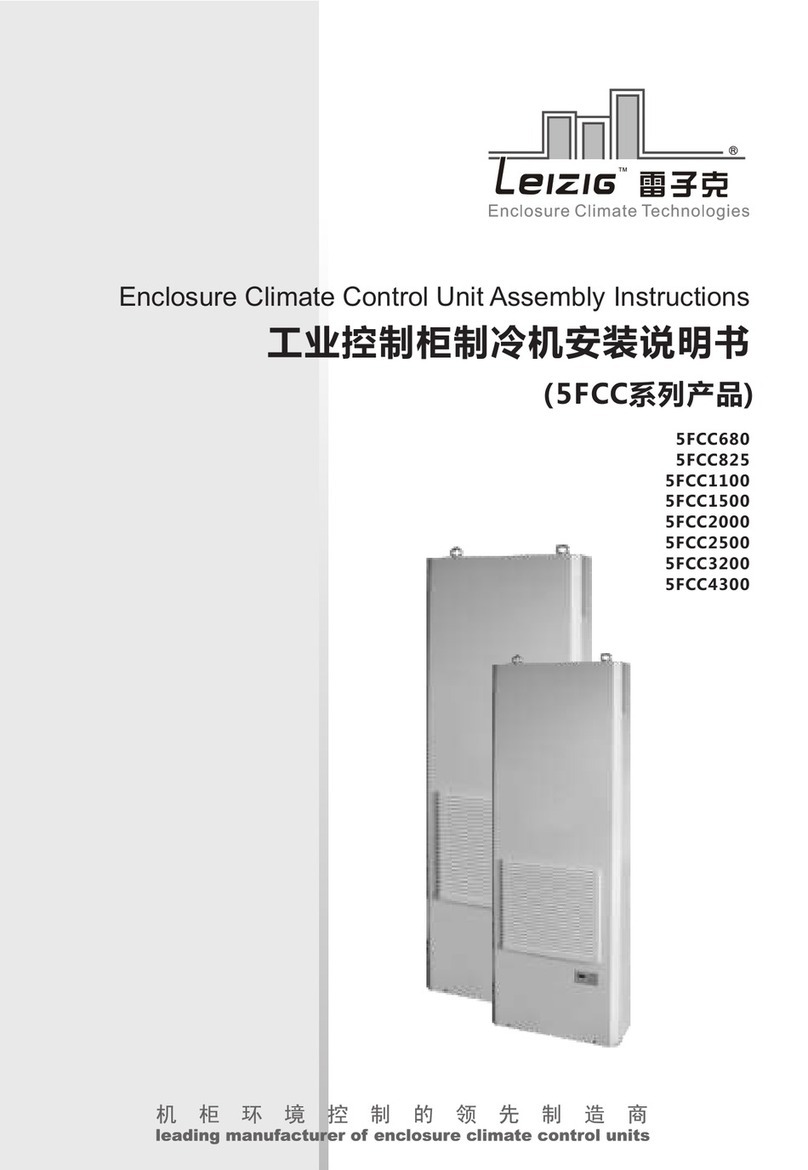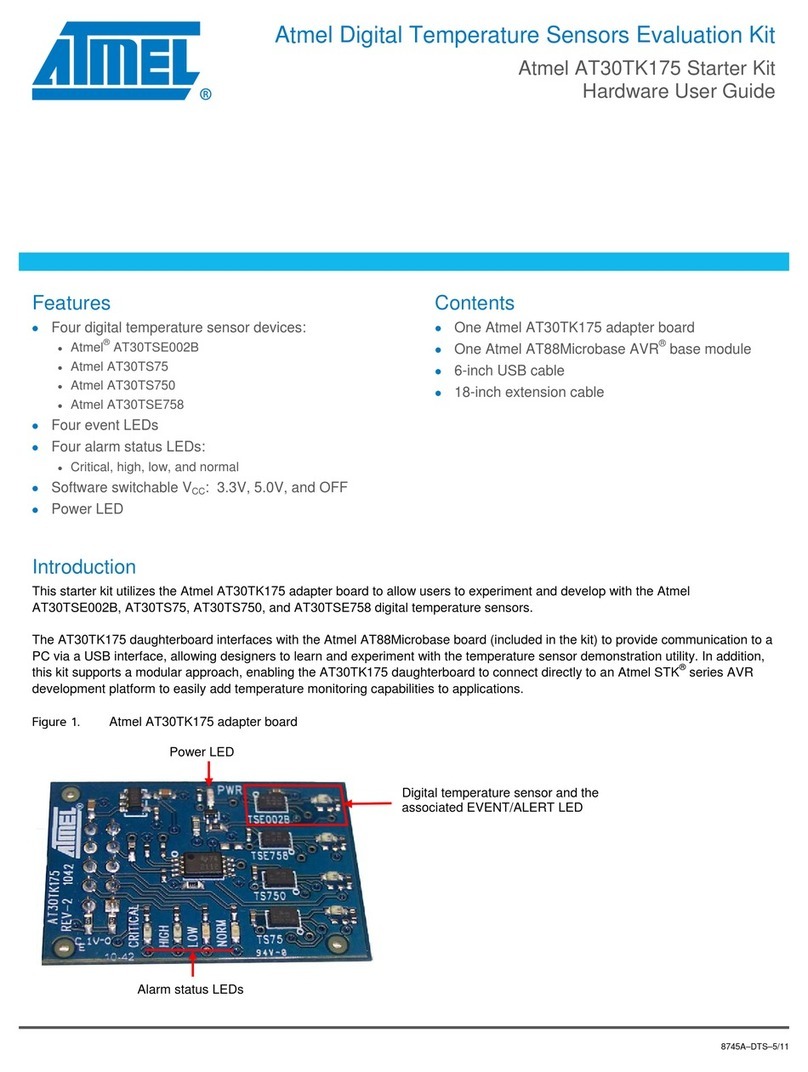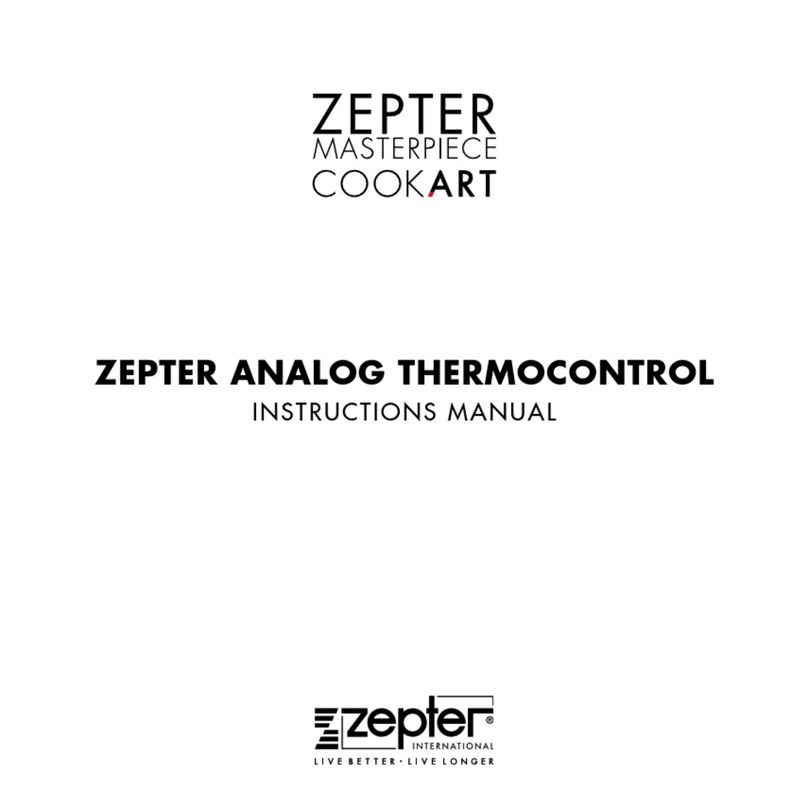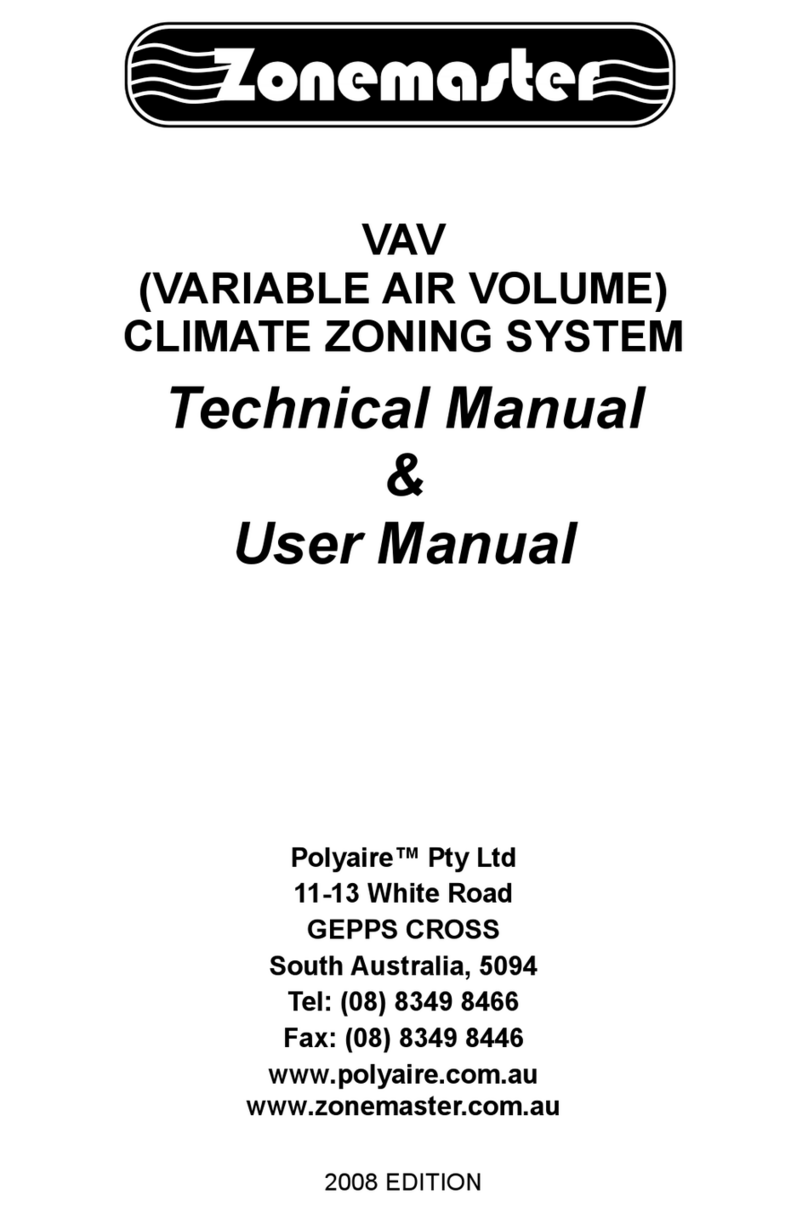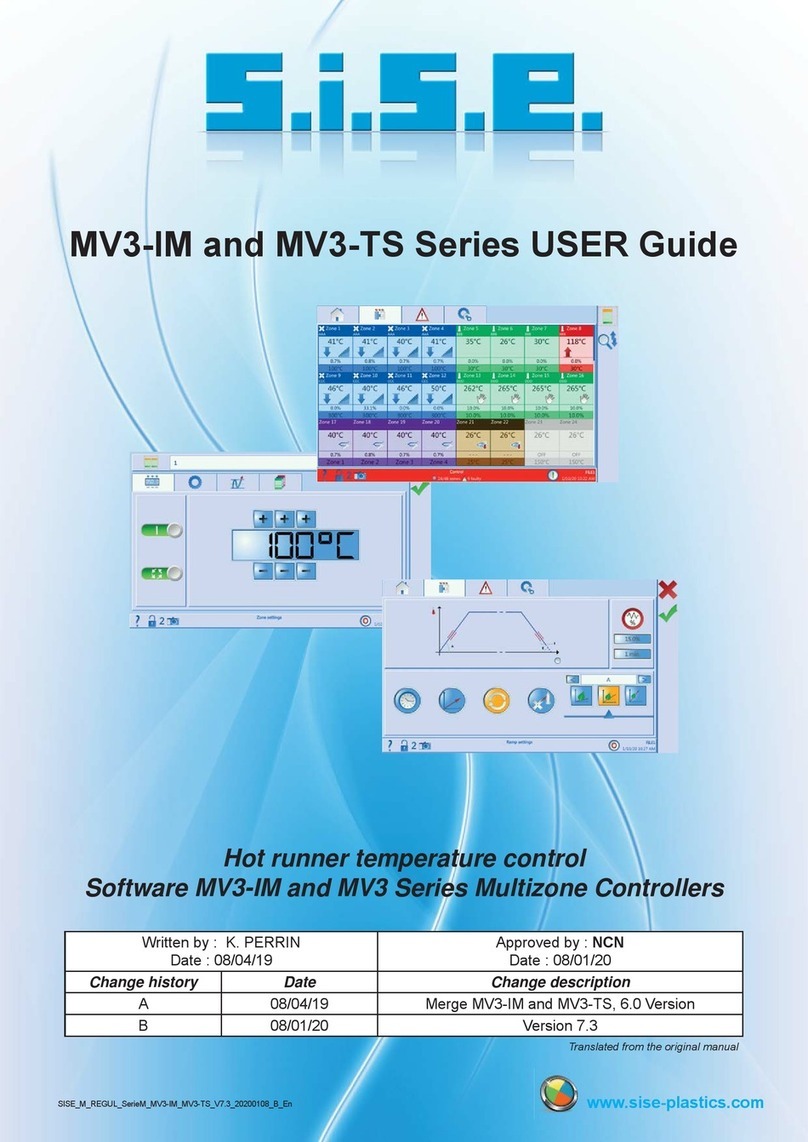KEY RK-2006LPG2 User manual

OPERATION MANUAL
RK-2006LPG2
Pellet fuel burner fitted boiler temperature controller.
Wersja 4B00


3
1. Application.
Controller RK-2006LPG2 is designed for temperature control of solid fuel fired water
boilers equipped with:
- Auger and feeding stoker working with the stoker,
- Blow-in fan,
- Ignition glow plug for automatic start,
- Central heating pump,
- Hot tap water pump or mixing pump (option),
- Alarm indicator or or ash removal system (option),
- Room thermostat (option).
2. Connection.
Before turning on the controller, connect: power cables of: controller, blow-in fan,
central heating and hot tap water pumps and auger to appropriate sockets in the
rear of the controller. The temperature sensor should be placed in metering locations
that shall be dry. Figure 2 presents the electrical connection diagram. For connection
of stoker, alarm indicator and ash removal system the additional module UM-1 shall
be applied.
CAUTION! Before plugging in the controller first check if the wiring system is
properly grounded, and if the terminal screws of the output connector are tightened.
CAUTION!Total power of the fan, central heating and hot water pump which are
connected to the controller must not exceed 900W. Outputs of the controller that are
not used may remain disconnected.
CAUTION! Control outputs of the feeder and lighter are not protected and MUST BE
protected with adequate fuses.
CAUTION! The controller is equipped with properly protected semiconductor
temperature sensors, yet metering locations with installed sensors must be dry.

4
3. Operation.
After power-up the controller displays the name and version of the software, then
goes to the state it was in before shutting down or lose power.
On the front panel of the controller (Figure ) there is:
1 – display,
2 – STOP button, reset the alarm and cancel the changes,
3 – START button and choose the parameter,
4 – the boiler thermostat knob and set the parameters and click OK,
5 – MENU button and choose the parameter,
6 – ESC / output.
Figure 1. Front panel of RK-2006LPG2 controller.
Basic operation of the device is to set the preset boiler temperature. In this hands?
U need to turn the boiler thermostat knob (4) to set the correct value and confirm it
with the OK button (or press the knob).
CAUTION! If you enter the room thermostat works in adaptive mode, you try to
change the set temperature of the boiler may end in failure, ie. After approval of the
new value of the controller can automatically change the boiler temperature to
a value that results from the operation of the adaptive algorithm.
CAUTION! If the heating system has a water heater, the water temperature in the
boiler maintained by the controller during the heating tray may be higher than the set
temperature of the thermostat knob.

5
Overview of display symbols.
1 – Thermostat work indicator,
2 – DHW temperature,
3 – DHW pump work indicator,
4 – Controller work mode,
5 – Boiler water temperature,
6 – Additional fan,
7 – Feeder work indicator,
8 – CH pump work indicator,
9 – Burner capacity indicator (the higher the capacity, the brighter the flame),
10– Cleaning device work indicator,
11– Fan,
12– Stoker work indicator,
13– Feeder temperature,
14– Return water temperature,
15– Mixing pump work indicator,
16– Ignitor work indicator.
17– Emergency power system work indicator.

6
4. Device operation modes.
Table 1. Operation mode list.
Operation mode. Description
STOP Boiler control stopped. Controller maintains central heating and domestic water
pump operation, but automatic ignition does not follow.
STAND-BY Controller maintains central heating and domestic water pump operation. In case
of heat demand automatic ignition of boiler follows.
IGNITION Controller carries out automatic ignition of boiler.
STABILIZATION
OF THE FIRING Fan control and feeder so as to stabilize the
the burner.
MAX. POWER Fan and fuel feeder operates to reach boiler max. power.
MODUL.
POWER Controller reduces fuel feeding as much as boiler water temperature
corresponds to the desired setting.
MINIMUM
POWER Fan and fuel feeder operation is minimize to maintain fire.
SCAVENGE
(AIR PURGING) Controller activates blower to ensure removal of accumulated gases.
AFTERBURNING No demand for heat or furnace needs cleaning. The controller turns off the tray
and burnout of fuel until the flame failure.
EXTINCTION The controller suppresses the boiler furnace.
CLEANING Burner cleaning.
AUGER
(MANUAL)
REFILLING
Manual operation of fuel auger. Boiler control stopped. Controller maintains
central heating and domestic water pumps operation, but automatic ignition does
not follow.
AUGER
EXTINCT
(EMERGENCY
SHUT DOWN)
Fuel ignition in auger channel. The controller empties ignited fuel from the auger
channel until temperature drops.
ALARMS Safety and temperatures sensors failure alarms.
STOP.
Controller maintains central heating and domestic water pumps operation only to
protect the boiler against overheating and auger channel ignition. Room thermostat
contacts closing(call for heat) and domestic water temperature drop do not result in
any action. Pressing START button will result in switching the controller to
STAND-BY mode.
STAND-BY.
In this mode controller does not carry out any additional operation, until room
thermostat contacts close (call for heat) or domestic water temperature drop, the
boiler operation will focus on maintenance of temperature according to thermostat
setting programmed with the knob. If preheating of domestic water tank is necessary
and the desired boiler temperature setting is higher from domestic water
temperature setting the controller will follow higher setting. Pressing the STOP
button () will result in switching to STOP mode.
IGNITION.
Boiler controller is switched into IGNITION mode if demand for heat follows, and if
the controller did not detect the flame. During ignition the controller activates fan,
auger and igniter. Fuel and air feeding rate is adjusted by the technician. IGNITION

7
mode follows till flame is detected. If the flame is not detected within the specified
time, the controller activates „Out of fuel alarm”. Pressing STOP button, exceeding
time limit for cleaning, thermostat contacts opening or if water temperature in
domestic water tank is obtained during operation in IGNITION mode will result in
switching of the controller into EXTINCTION (SHUT DOWN) mode.
Stabilization of the firing.
Boiler burner is switched to the stabilization of the detected flame ignition. While
stabilizing the fan runs at a speed the same as when operating in maximum power.
Tray gives fuel quantity such as the minimum power. In addition, depending on the
service settings fuel dose may be increased gradually. Stabilization of the firing
continues for the time programmed in the settings of the service or until the boiler
temperature. Pressing the STOP button, exceeding the working time without
cleaning, opening the contacts of the thermostat or to achieve the required water
temperature in the hot water tank during operation stabilization ignition, the controller
will switch to after-burning mode.
CAUTION! Stabilization of ignition can be turned off by a service technician. In this
case, after the fire the controller switches to work with maximum power.
MAX. POWER OPERATION MODE.
When in this mode the controller operates fuel auger and fan to ensure max. power
of the boiler. Fuel and air feeding rate is adjusted by the technician. Pressing STOP
button, exceeding time limit for cleaning, thermostat contacts opening or if water
temperature in domestic water tank is obtained during operation in MAX. POWER
mode will result in switching of the controller into EXTINCTION (SHUT DOWN)
mode.
MODULATED POWER OPERATION MODE.
Depending on desired parameters the controller may gradually reduce fuel and air
rate feeding to reduce burner power, as much as boiler water temperature
corresponds to the programmed setting. Pressing STOP button, exceeding time limit
for cleaning, thermostat contacts opening or if water temperature in domestic water
tank is obtained during operation in MODULATED POWER mode will result in
switching of the controller into EXTINCTION (SHUT DOWN) mode.
MINIMUM POWER OPERATION MODE.
When in this mode the controller operates fuel feeding and fan operation to maintain
firing to ensure the minimum fuel consumption. Fuel and air feeding rate is adjusted
by the technician. If in spite of boiler minimum power, increase temperature follows
of water temperature in relation to the top hysteresis parameter setting, the controller
will be switched into EXTINCTION(SHUT DOWN) mode. When the boiler water
temperature drops below the desired setting it will result in switching of the controller
into „max power operation mode”. Pressing STOP button, exceeding time limit for
cleaning, thermostat contacts opening or if water temperature in domestic water tank
is obtained during operation in MINIMUM POWER mode will result in switching of
the controller into EXTINCTION (SHUT DOWN) mode.

8
SCAVENGE (AIR PURGING).
During the operation with minimum power output, the controller will activate flue
scavenge (purging) to ensure removal of accumulated gases. Scavenge (purging) is
provided with temporary fan operation in higher speed.
EXTINCTION (SHUT DOWN).
When in this mode the controller turns off the fuel auger and engages the fan to
ensure complete fuel combustion and the burner cool down. Fan power when in
EXTINCTION (SHUT DOWN) mode is determined by the technician. When
EXTINCTION (SHUT DOWN) is finished the controller is switched into CLEANING,
STAND-BY or STOP mode, provided EXTINCTION (SHUT DOWN) followed as
a result of STOP button pressing.
Blanking mode.
In this mode, the controller changes the fan speed on the value programmed by a
service technician to burn off excess fuel and cool the burner. After putting out the
fire controller switches to CLEANING, ARMED or STOP depending on what caused
the start of the sequence Afterburning EXTINCTION.
CLEANING.
Automatic burner cleaning occurs after time set limit by programmer. In this mode
controller starts cleaning system for preset time. After this procedure controller
resets back to STANDBY mode.
AUGER (MANUAL) REFILLING.
User may activate auger manual refilling function. When device is in STOP mode,
press START and hold button for 5 seconds to start refilling. Refilling follows
according to the time programmed by the technician or until it is manually turned off
with STOP button.
AUGER EXTINCTION (EMERGENCY SHUT DOWN).
If the auger is equipped with a temperature sensor, a temperature increase above
the range programmed by the technician, it will result in activation of auger ignition
alarm. The controller turns off the fan and auger. If the burner is equipped with the
stoker, the device is switched additionally into AUGER EXTINCTION(EMERGENCY
SHUT DOWN) mode. During shut down the stoker is engaged for the time needed to
remove the ignited fuel from the stoker. In addition if the burner has cleaning
mechanism, the controller will activate the cleaning cycle and remove fuel from the
burner.

9
ALARMS.
RK-2006LPG2 controller continually checks operations of installed devices as well
as alarm sensors. In case of failure, the device activates alarm and proper
operations are carried out. Information on the problem is also shown on the display.
In addition depending on nature of damage the inner sound alarm system may be
activated. To cancel alarm, first identify the cause and repair it and then STOP
button shall be pressed. If alarm is cancelled and required repairs did not follow,
sound alarm system will be turned off only. In case more than one alarm has been
activated, information on each alarm will be displayed alternately.
Out of fuel alarm.
If in IGNITION mode the controller fails to detect a flame within the time specified by
the technician, „Out of fuel alarm” will be activated. To turn on the controller again
first refill fuel, cancel the alarm with STOP button and begin setting-up process by
pressing START button.
Emergency alarm.
Depending on construction type, the boiler may be equipped with emergency sensor
(e.g. hopper cover sensor). Activation of the alarm will result in fan and auger turning
off, and switching the controller into STAND-BY mode.
CAUTION! This alarm does not result in engagement of inner sound system and
does not require cancelling. Once the hopper cover is closed, the programmed
process will be carried out from the moment when it was interrupted (it returns to the
mode that was before alarm activation).
Auger ignition alarm.
If the auger has been equipped with a temperature sensor, and the programmed
setting of „Auger ignition temperature" was exceeded, it will result in activation of
auger ignition alarm. The controller will go to SHUT DOWN mode.

10
CAUTION! This alarm may be cancelled only if the auger temperature drops below
set point. If the alarm was cancelled before extinction completion, only sound alarm
will be turned off.
Auger sensor damage.
In case of auger temperature sensor damage, as in case of overheating, the
controller will go to shut down mode and will activate the appropriate alarm:
CAUTION! This alarm may be cancelled only after repairs.
Burner temperature sensor damage.
If flame temperature detector (CT-1/2 or PT-1000) has been connected to the
controller, its damage will result in activation of the alarm and switching into
STAND-BY mode.
Protection against overheating and overheating of the boiler.
RK-2006LPG is protected against overheating of the boiler. If the water temperature
reaches a preset value in parameter TEMP service. MAXIMUM THE BOILER, the
controller activates the pump absolutely CO. The increase in water temperature in
the boiler to the value programmed in parameter service TEMPERATURE BOILER
OVERHEAT will turn off the fan, heating pump, switch the controller to STOP mode
without starting the process of extinction and trigger the alarm:
CAUTION! This alarm may be cancelled, if boiler water temperature drops below the
overheating temperature setting.

11
Boiler temperature sensor damage.
In case of boiler water temperature sensor damage the controller turns off the fan,
engages central heating pump, controller switches into STOP mode and activates
alarm:
CAUTION! This alarm may be cancelled, only if repairs are made.
Domestic water temperature sensor damage.
If the heating system is fitted with domestic water circuit, in case of sensor damage
the controller turns off the domestic water pump and activates alarm:
CAUTION! This alarm does not require cancellation. The alarm is deactivated
automatically, if repairs are made.
Return water temperature sensor damage.
If the heating system is provided with the mixing pump, in case of return water
temperature sensor damage, the pump is switched off and the controller activates
alarm:
CAUTION! This alarm does not require cancellation. The alarm is deactivated
automatically, if repairs are made.
5. Preview and set user parameters.
Pressing the MENU button we can view the following user parameters.

12
The user can switch between different parameters by turning the knob (4).
By pressing the knob you enter the mode of change of the selected
parameter – the parameter will be backlit. You can change the value of the
selected parameter by turning the knob. To confirm the change press the
knob again, and the controller will return to the list of parameters. To leave
the mode of change and restore the previous value of a parameter, press
the MENU or ESC button. If the device is left either in the changing or
viewing the parameters mode for 60 seconds, removal of the modification
introduced recently and switching in the mode of displaying the device
status will occur automatically.
Table 2. User settings list.
L.p Parameter Min Max
1.1 Fuel type. 1 4
1.2 Desired boiler temperature. 40°C 90°C
1.3 Boiler max. power. 60% 100%
1.4 Central heating pump operation mode. WINTER SUMMER
1.5 Domestic water desired temperature. 30°C 60°C
1.6 Domestic water heating priority. NO YES
1.7 Domestic water tank bacterial flora liquidation program. NO YES
1.8 Measured domestic water temperature.
1.9 Measured return water temperature.
1.13 Current furnace brightness (FD–1).
1.14 Ignitor turn-off depending on the illuminance value. 0 255
1.10 Temperature of the burner (PT–1000, CT–1/2).
1.11 Ignitor turn-off depending on the temperature. 200°C 500°C
1.15 Burner running time.
1.16 Number of inflammation burner.
1.17 Boiler is turned on. NO YES
1.18 DHW heating is turned on. NO YES
1.19 Alarms cancellation.
1.20 Burner working mode. (CONTINUOUS), CYCLIC)
1.1 Fuel type selection.
RK-2006LPG controller enables programming ignition settings for four different fuel
types. „Fuel type” parameter enables switching between particular settings. Fan,
auger and igniter operation are saved for the selected fuel type.
PELLET 1,2,3 and WOOD. When the WOOD fuel is set, you can burn the wood in
the pellet boiler – the controller operates at the wood fuel burning settings.
WOOD/PELLET – once the wood has been burned, the controller switches to pellet
burning and full service to the pellet boiler is provided.

13
CAUTION! Fuel type may be changed, if the controller is in STOP mode only.
1.2 Desired boiler temperature – it is the temperature setting that will be obtained
by the controller, if room thermostat input contacts are closed.
1.3 Boiler operation max. power.
Boiler operation max. power – this parameter enables to limit boiler operation max
power. Power limitation is possible thanks to fuel reduction during operation at
maximum power.
1.4 CH pump work mode – WINTER/SUMMER – you can turn off the heating du-
ring summer by selecting the SUMMER value. The parameter indicates the CH
pump work will be turned off. When in the mode, the regulator controls the boiler to
feed the domestic hot water circulation
only.
1.5 Domestic water desired temperature – parameter that specifies temperature
of water in domestic water tank that will be obtained by the controller.
1.6 Domestic water heating priority – this parameter specifies operation of central
heating and domestic water pumps during hot water preheating. When priority is
selected during operation and hot water preheating, the controller engages domestic
water pump and switches off central heating pump. This operation results in quick
heating of water in the tank. During preparation of hot water without priority option,
central heating and domestic water pumps operation follow at the same time.

14
1.7 Bacterial flora liquidation in domestic water tank – the controller enables
manual activation of program for bacterial flora liquidation in domestic water tank.
When „YES” is selected, it activates the process of heating the domestic water tank
above 75°C. When the required temperature is obtained the controller switches off
the bacterial flora liquidation program automatically.
CAUTION! Bacterial flora liquidation option shall be switched on in the night or if
water intake does not follow from the domestic water tank, to protect the user
against burning.
1.8 Domestic water measured temperature – the controller enables to view the
temperature measured in domestic water tank.
CAUTION! In case the heating system is not fitted with the DHW circuit, it is not
possible to view or change the above parameters.
1.9 Return water temperature.
If the heating circuit is equipped with the mixing pump and return temperature
sensor, this option enables view of the return water temperature. Otherwise, this
option in unavailable.
Flame optical detection parameters.
These parameters specify operation of burner flame optical detector. If the system is
fitted with flame temperature detector, parameters change and viewing is
unavailable.
1.13 The current furnace brightness determined by an optical detector – this
parameter displays the current flame brightness measured by the optical detector.

15
1.14 Brightness when fuel ignition has occurred – if the optical detector reading
will be equal or higher than this desired setting, the controller will switch off the
igniter and assume that ignition has occurred.
Flame detection temperature parameters.
These parameters specify operation of the temperature detector of burner fuel
ignition. If the system is fitted with optical fire burner detector, parameters change
and viewing is unavailable.
1.10 Burner measured temperature – this parameter displays the current measu-
red burner temperature.
1.11/1.12 Burner temperature with fuel ignited - if ignition temperature is equal or
higher than this desired setting, the controller will switch off the lighter and assume
that ignition was provided.
Information on burner work.
Parameters described below refer to counters that accumulate information on
operation of the burner since its first start. It is not possible to cancel counter
readings.
1.15 Burner work time.
Reading of this counter defines burner work time. The counter updating follows after
total working hour of the device at maximum or minimum power.
1.16 Burner start up counter.
Reading of this counter defines start number of the ignition attempts.
1.17 Boiler on.
The parameter informs the user if the boiler is turned on and allows him/her to turn it
on or off.

16
1.18 DHW heating on.
The parameter informs the user if the DHW heating is turned on and allows him/her
to turn it on or off.
1.19 Alarms cancellation.
The parameter enables the user to cancel the alarms recorded in the controller data
storage.
1.20 Burner mode.
CYCLIC – turning off the thermostat will cause the controller to switch into the
POSTCOMBUSTION mode.
CONSTANT – once the thermostat is turned off, the controller will switch into the
MINIMUM CAPACITY mode instead of the POSTCOMBUSTION (the mode saving
the ignitor).
6. Setting the parameters – service mode.
Service parameters are divided into groups. For each group are assigned
service parameters possible to change. Entry into service mode after press and hold
for about 3 seconds the MENU button. regulator displays a list of service parameters
possible to edit and change.
Viewing the list of parameters is possible by turning the multifunction knob - possible
to edit the parameter is highlighted. After selecting the desired parameter press the
OK button (knob), and enter the subgroups of a given parameter. Select the parame-
ter you want to change and press the knob - a parameter is highlighted. Turning the
knob set the desired value and then press the knob. Giving up mode changes and
restore the previous value of the parameter by pressing the STOP button or ESC. If
the unit is left in a mode change or view the parameters for 60 seconds, the control-
ler will automatically withdraw the recently introduced modification and switch to di-
splay the status of the device. A list of all service parameters presented in the table.
The table columns contain the following order: group number, name of the parame-
ter and the value of the minimum and maximum possible settings.

17
Table 3. Table service parameter.
Lp. Parametr Min Max
2.x
Overall
2.1 Language. (see description)).
2.2 Brightness of the display.
2.3Saturation.
2.4 Contrast.
2.5 Service settings. NO YES
2.7 Output testing. NO YES
3.x
Fan
3.1 Fan modulation during boiler start. NO YES
3.2 Min. fan speed during heating up. 1% 100%
3.3 Max. fan speed during heating up. 1% 100%
3.4 Ignition modulation start delay. 0s 250s
3.5 Fan speed during ignition. 1% 100%
3.6 Fan speed at max. power. 1% 100%
3.7 Fan speed at min. power. 1% 100%
3.8 Fan speed at extinction. 1% 100%
3.9 Fan speed during cleaning mode. 0% 100%
3.10 Fan scavenge (air purging). NO YES
3.11 Fan scavenge (air purging) blow time. 5s 60s
3.12 Fan scavenge (air purging) pause time. 1min 99min
3.13 Fan speed during scavenge. 1% 100%
4.1 Auger filling tim. 1min 99min
4.2 Initial fuel feed. 0s 250s
4.3 Fuel feed cycle. 1s 250s
4.4 Fuel feed during ignition. 0% 100%
4.5 Fuel feed for max burner power. 1% 100%
4.x
Auger
4.6 Fuel feed for min. burner power. 1% 100%
4.7 Stoker work mode (See description).
4.8 Stoker work time. 1s 99s
4.9 Stoker pause time. 1s 99s
4.10 Stoker extra work time. 1s 99s
4.11 Stoker emptying time. 1s 99s
4.12 Auger ignition test. NO YES
4.13 Auger ignition temperature. 20°C 99°C
5.x
Igniter
5.1 Flame detector type: FD–1, PT–1000, CT–1/2.
5.2 CorrectionFD–1. 0 99
5.3 Hysteresis loss of flame (temperature sensor). 1°C 250°C
5.4 Hysteresis loss of flame (optical sensor). 1 255
5.5 Flame failure detection delay. 1s 500s
5.6 Fuel ignition timea. 1min 15min
5.7 Ignition try count. 1 10
5.10 Firing stabilization. NO YES
5.11 Stabilization time firing up. 1min 99min
5.12 Smooth stabilization firing. 1min 99min
5.13 The blanking time the furnace. 1min 30min
5.15 Blower at pellet burning mode.
5.16 Blower at the wood burning mode.
6.x
Cleaning
mechanism
6.1 Mode of operation of the cleaning mechanism: CYCLE,
ROTO, AUTO, COMBI, COMBI2
6.2 Cleaning mechanism work time. 1s 900s
6.3 Cleaning mechanism retraction time. 1s 900s
6.4 Cleaning mechanism pause time. 1s 900s
6.5 Opening time cleaning mechanism. 1s 900s
6.6 Closing time cleaning mechanism. 1s 900s
6.7 Number shut downs before cleaning. 1 99

18
6.8 Minimum operating time without cleaning. 0h max–1h
6.9 Maximum working time without cleaning. min+1h 99h
7.x
CH pump
7.1 Central heating pump work mode: TERM, AUTO.
7.2 Central heating pump periodic work. NO YES
7.3 Central heating pump periodic work time. 1min 99min
8.x
HTW pump
8.1 Domestic water path: OFF, ON, MIXING PUMP,
8.2 Domestic water heating hysteresis. 1°C 20°C
8.3 Boiler increase temperature during hot tap water heating. 2°C 20°C
8.4 Domestic pump work extension. NO YES
8.5 Domestic pump work extension time. 1min 10min
8.6 Stabilization time. 1min 99min
8.7 Mixing pump engaging temperature. 30°C 60°C
8.8 Mixing pump work hysteresis. 1°C 9°C
9.x
Thermostat
9.1 Boiler minimum temperature. 30°C 69°C
9.2 Boiler maximum temperatur. 70°C 90°C
9.3 Boiler upper hysteresis. 1°C 20°C
9.4 Boiler power switching hysteresis. 1°C 9°C
9.5 Boiler protection hysteresis. 1°C 5°C
9.6 Boiler overheating temperature. 90°C 99°C
9.7 Burner power modulation. NO YES
9.8 Modulation factor. 1 20
9.9 The operating mode of the thermostat: NORM, ADAP.
9.10 The time constant adaptation. 1min 99min
9.11 Burner off delay. 0min 99min
10.x
Data
transmission
10.1 Data link: (see description). OFF, MODBUS RTU.
10.2 MODBUS device number. 1 247
10.3 MODBUS channel capacity: 2400, 3600, 4800, 7200,
9600, 14400, 19200, 28800,38400, 56000, 57600, 76800,
115200.
10.4 MODBUS frame format: 8N1,8E1, 801, 8N2.
10.5 MODBUS access level: NONE, READOUT,
USER’s, SERVICE.
10.6 Terminal access level: NONE, READOUT,
USER’s, SERVICE.
11.x
Fan 2
11.1 Blower 2; ON, NONE.
11.2 Modulation of blower speed rate at ignition. NO YES
11.3 Minimum blower speed at ignition. 1% 100%
11.4 Maximum blower speed at ignition. 1% 100%
11.5 Modulation turn-on latency at ignition. 0s 250s
11.7 Blower speed rate at the maximum capacity. 1% 100%
11.8 Blower speed rate at the minimum capacity. 1% 100%
11.9 Blower speed rate at extinction. 1% 100%
11.10 Blower speed at cleaning. 1 247
11.11 Blower draught. NO YES
11.12 Draught duration. 5s 60s
11.13 Silence between draughts duration. 1min 99min
11.14 Blower speed at draught. 1% 100%
12.x
Emergency
power system
12.1 Power supply malfunction control: NONE,ON.
12.2 Turn-off latency. NO YES
12.3 Power supply shortage mode: POSTCOMBUSTION,
CLEANING
12.4 CH pump work NO YES
12.5 DHW pump work NO YES

19
2.x Overall.
2.1 Language selection.
RK-2006LPG2 controller interface offer the function of language selection. Number
of available languages depend on software version being used.
2.2–2.4 Brightness, saturation, contrast of the display.
The parameters enable the user to adjust the display to his/her own needs.
2.5 Service settings – setting and confirm with the OK button to display the value
YES when this option will delete all the parameters and assign them to the pre-pro-
grammed by the installer or service technician.
2.7 Testing out.
In order to verify the correctness of the controller, it is possible to test various output
devices. This feature is available in service mode only if the adjustment process is
stopped, ie. The regulator before entering the service mode was in STOP mode.
Selecting output testing allows the control knob to select the outputs on the display.
Pressing OK allows you to temporarily attach the selected output. In order to
complete the testing procedures exit, press the STOP button.

20
3.x Fan operation parameters.
3.1 Fan modulation during boiler start – selection of „YES” setting means that fan
speed modulation will be provided during boiler start.
3.2 Min. fan speed during heating up – this parameter is available, if the function
of fan modulation during boiler start is selected. This parameter specifies power of
the fan during boiler start.
3.3 Max. fan speed during heating up – this parameter is available, if the function
of fan modulation during boiler start is selected. This parameter specifies power of
the fan at end of boiler start.
3.4 Ignition modulation start delay – this parameter is available, if the function of
fan modulation during boiler start is selected and it describes operation time of the
fan with speed according to the selected „Min. fan speed during boiler start” setting.
After time expire the controller will increase fan speed up to the selected „Max. fan
speed during boiler start” setting.
3.5 Fan speed during ignition – this parameter describes power of the fan speed
during ignition. This parameter is unavailable if „Fan speed modulation during
ignition” was selected.
Table of contents
Other KEY Temperature Controllers manuals
Popular Temperature Controllers manuals by other brands
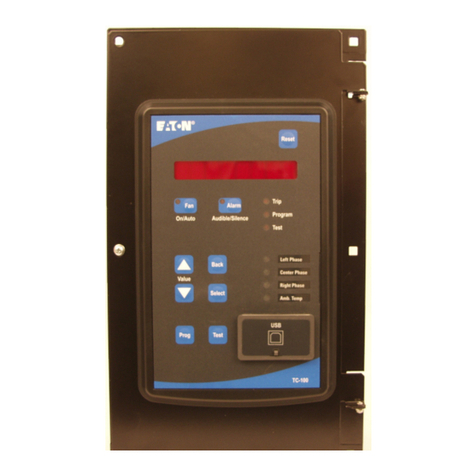
Eaton
Eaton TC-50 Modbus instruction manual
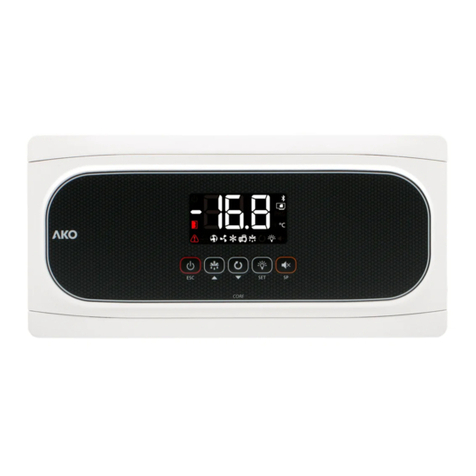
AKO
AKO AKO-16524A user manual

Glas-Col
Glas-Col Temp-O-Control TOT-1200 operating instructions
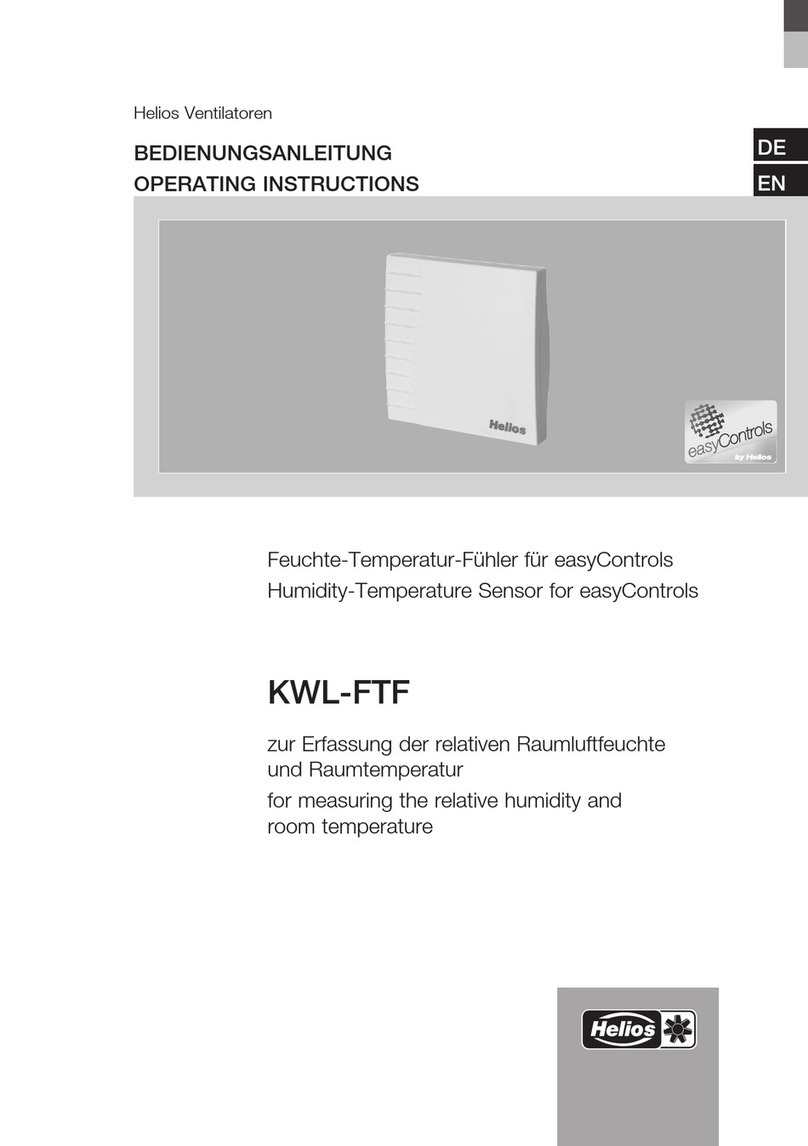
Helios
Helios KWL-FTF operating instructions
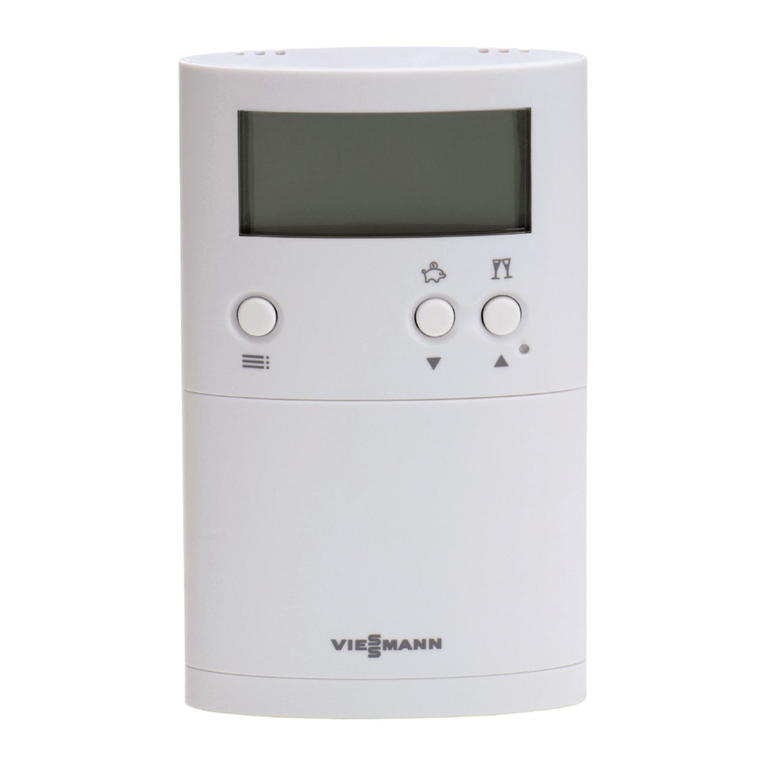
Viessmann
Viessmann VITOTROL 100 Operating Instructions for the System User
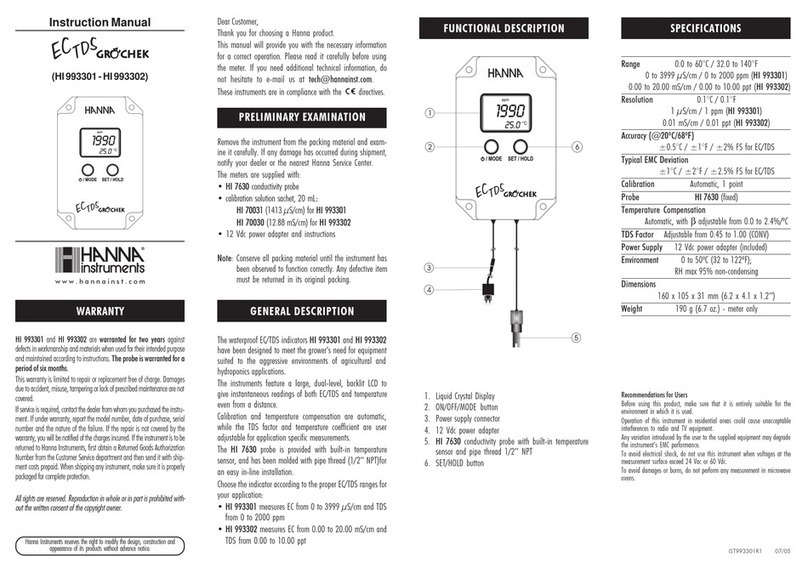
Hanna Instruments
Hanna Instruments HI 993301 instruction manual
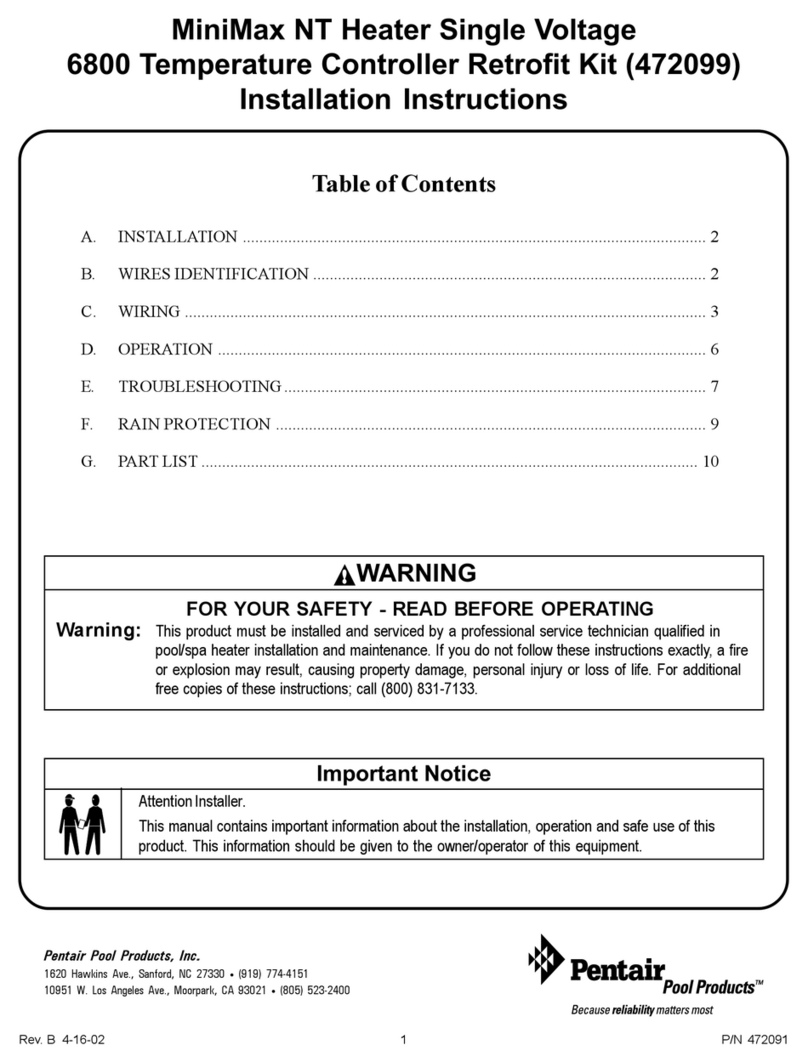
Pentair Pool Products
Pentair Pool Products 6800 installation instructions

Novus
Novus N323 operating manual
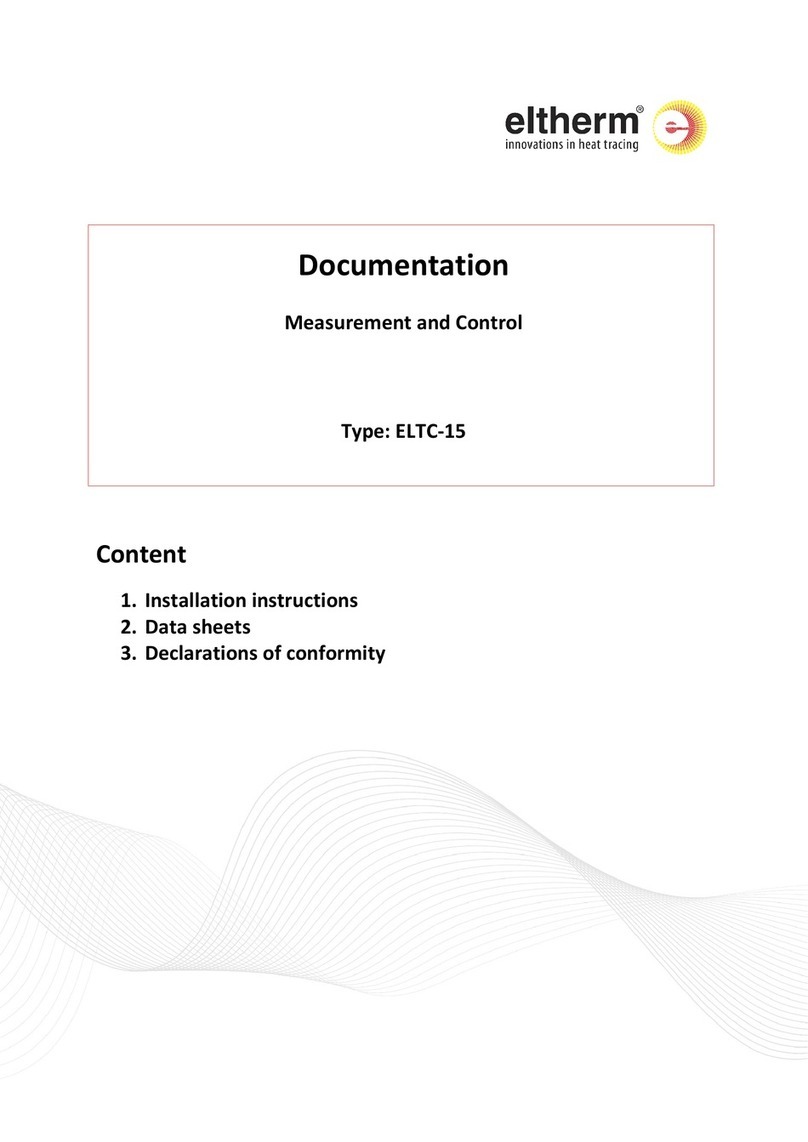
eltherm
eltherm ELTC-15 operating manual

Sensaphone
Sensaphone FGD-0109 Quick installation guide
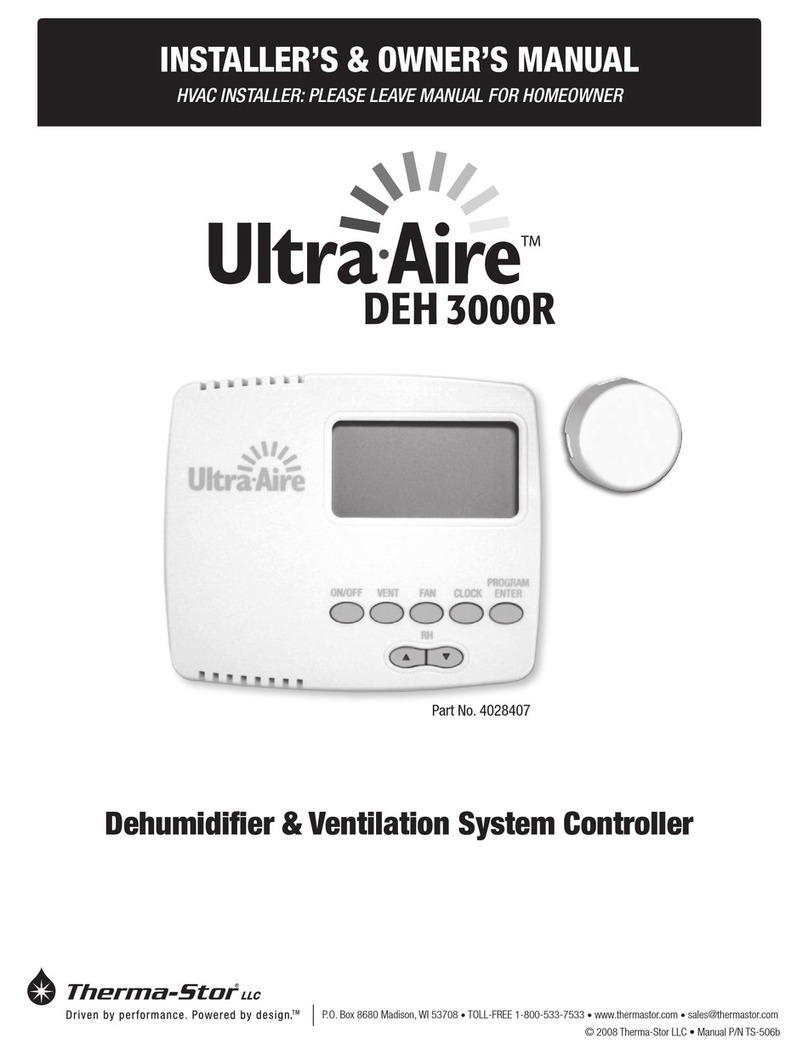
thermastor
thermastor Ultra-Aire DEH 3000R Installer's & owner's manual
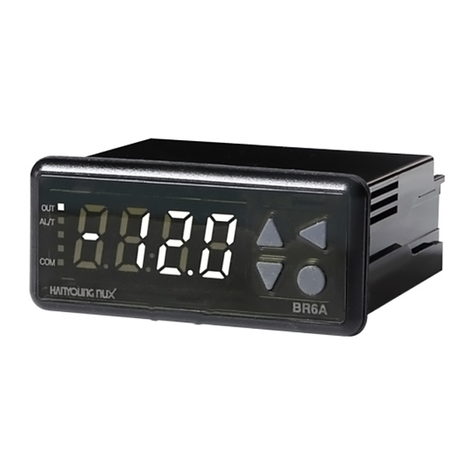
HANYOUNG NUX
HANYOUNG NUX BR6A instruction manual
